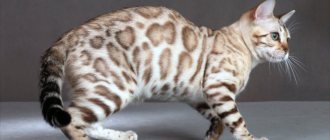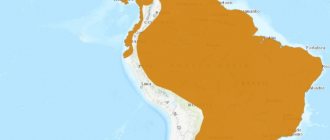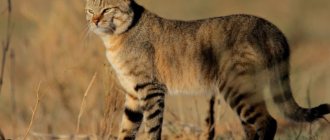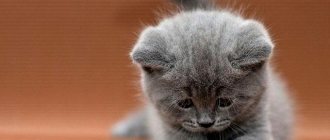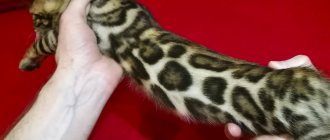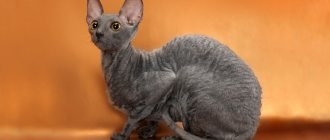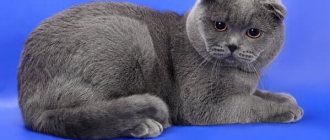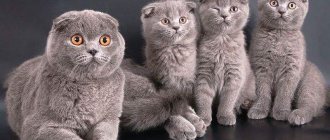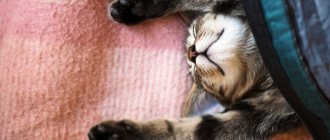Origin story
People first started talking about kinkalow in the late 90s. A certain Terry Harris, a breeder from the USA, brought together an American Curl and a Munchkin. Whether he wanted to get a breed with short legs or everything happened completely by accident: now we can only guess.
And then babies were born who inherited from their parents their most obvious physical features: curved ears and short legs. The breeder was delighted and named the new breed Kinkalow, which translates as “little curl.”
In 1997, Harris' application for registration with TICA was granted. In 2008, the breed was recognized as experimental and was recognized by TICA - the Toy Cat Association. But the experimental status - alas! — imposes many restrictions, and they are still not recognized by most large felinological organizations.
Health
The Kinkaloo breed is renowned for its good health and physical stamina. These animals are not prone to any genetic diseases.
Of course, a pet can catch an infection and become infected with parasites.
To prevent this from happening, it is important for owners to take care of quality nutrition, timely vaccination and deworming of their pet.
Representatives of this breed are especially sensitive to ultraviolet radiation, which can negatively affect their health.
Therefore, it is extremely important to protect your pet from overheating.
Every six months, the animal must be shown to a veterinarian for preventive purposes.
On average, the lifespan of a kinkalow is about 10–15 years.
Standard
An official standard for the breed has not yet been drawn up: its status does not allow it. But the general characteristics are as follows: Kankalow are dwarf cats, i.e. miniature. The largest known individuals weigh only 3 kg and reach a height of 16 cm.
| Standard | Description |
| Head | Small, wedge-shaped, sloping, narrow forehead. |
| Ears | They are spaced wide apart, their tips are turned outward. The inside of the auricle is abundantly covered with hair. |
| Eyes | Round, medium size. The iris can be colored blue, yellow or green. |
| Torso | Muscular, but does not look overly massive. The chest is wide, the limbs are short, stocky, the paws are round and flattened. The pads are painted pink. |
| Tail | Long, thin, densely pubescent. |
Newborn kittens' ears are always even and smooth, but gradually they begin to bend back.
The price for an individual is high: the minimum amount is 150,000 rubles. Moreover, males are cheaper than females (it’s clear why: after all, you can get offspring from a female). There are few official nurseries: in the UK, in the United States of America and in Russia (kittens are brought there from the States through an intermediary).
Character and behavior
We still need to look for such affectionate and friendly creatures. Good-natured, cheerful, trusting and very sociable kinkalows will get along well in any home, both with adults and children. Even in adulthood, even in old age, kinkalows behave like kittens, playful and mischievous. They love to be the center of attention and are not afraid of noisy companies and loud people.
Despite their small stature, these cats love to run and jump, like all other cats. Short legs are not a hindrance: kinkalows try to climb higher and jump further, stick their wet nose into every corner that seems interesting to them, and will try their best to get to the thing they like.
They do not have conflicts and do not pretend to be the leader in the house, which means that they will be able to get along well with all other living creatures in the house: be it a dog, cat, bird or hamster. If a conflict arises, they will prefer to simply leave.
They quickly adapt to new living conditions, the main thing for them is the presence of a loved one nearby. When alone, they feel very sad and refuse both food and contact with others. For relaxation they prefer covered houses. They love toys, and the more of them, the better.
They love walks in the fresh air and quickly learn to use a leash. Females are more fearful than males, so they do not strive to leave their familiar territory, but males during the mating season can easily go in search of love adventures many kilometers from home.
Name the cat who always wanted to live together
BasilioLeopold
A funny feature of the kinkalow is the ability to sit on its tail. They look like miniature kangaroos.
Kinkalow appearance
Kinkalows have a memorable appearance: from Munchkins and American Curls they got short legs and unusual ears. It is noteworthy that at birth the ears of the Kinkalow are straight, and they bend 90–180 degrees a couple of weeks after birth and are finally formed by 5 months of life. This breed has a tiger-like head shape, a wide bridge of the nose, round eyes, a muscular build and a graceful long tail. The cats are very miniature, their weight is no more than 3 kg, and their height at the withers is about 20 cm.
A movable skeleton allows you to lead an active lifestyle, regardless of your short stature.
The color of the kinkalow's eyes depends on the color and can be different. There are cats with a pale blue, yellow or yellow-green tint.
Features of coat and color
A distinctive feature of the Kinkalow is also its soft shiny coat, which can be either short or long. There are different colors: from colorpoint to albino. The most common are chocolate, bicolor, seal and tabby.
Despite the fact that this breed is not so common, there is already a lot of diversity and all sorts of color variations.
Care instructions
Caring for a kinkalow is quite simple. Babies are afraid of water, but if you teach your kitten to water procedures from childhood, he will be patient. Pour warm water, buy special shampoo: Rolf Club, “Clandestine”, Beaphar Shampoo Anti-Itch, CitoDerm, Api-san, Iv San Bernard Lemon. Give the kinkalow a separate soft towel and dry it with a hairdryer after bathing.
Human shampoos and pastes cannot be used: they contain harmful components and cause serious harm to the health of cats, provoke gastrointestinal disorders, asthma and even cause the growth of tumors.
Ears
Ear wax is cleaned every week using soft cotton swabs soaked in chlorhexidine or ear lotion.
Teeth
Teeth - 2 times a week using a special brush (or an ordinary children's brush, the bristles of which should be cut exactly in half) and cat toothpaste.
Claws
If your kinkalow often goes for walks outside and wears its claws off on trees, you have nothing to worry about. You can also rest assured if your cat has mastered the scratching post. Otherwise, you will have to trim her claws yourself every week using a nail clipper (we recommend reading the article on how to trim a cat’s claws). Secure the cat (you can wrap it in a towel) and carefully trim the tips of the claws at an angle. If you hit a vessel and blood appears, treat the wound with hydrogen peroxide.
Expert opinion
Dusheba Vera Ivanovna
In 2010, she graduated from the Moscow State Academy of Veterinary Medicine named after K.I. Scriabin with honors, specializing in veterinary medicine. I regularly attend veterinary conferences, congresses, and webinars.
Many cat owners, trying to protect furniture and wallpaper from damage, take their pets to veterinarians for declawing. The procedure, called “soft paws,” involves mutilation of the cat. Even if the cat does not begin to bleed during the procedure and does not begin to die of tissue in the future, after declawing the cat’s coordination of movements is irreversibly impaired, its character and habits change.
Cats are no longer able to deftly rummage through the litter box, and often they begin to simply ignore it. They lose confidence when jumping and will no longer be able to stand up for themselves and go out hunting. Only damaged claws should be removed and only for medical reasons!
Breeding Maine Coon Cats
Breeding purebred cats is considered a profitable and highly paid occupation. The Maine Coon is one of the 10 most expensive cats in the world. To obtain permission to breed, the cat must take part in the exhibition at least 3 times.
Krasnodar WCF Club “PERSONA-cat” “PERSONA-show-IX”
Documentation
To participate in the exhibition and obtain permission to breed Maine Coon cats, the following documents are required:
- Contract of sale
- Kitten birth metric
- Pedigree
You can sell kittens without a pedigree and a metric only at a significantly reduced price to cat lovers who are not interested in breeding Maine Coons.
How to buy
You can buy a Maine Coon in any nursery in the world, as it is a fairly popular breed. At the same time, it is not at all necessary to go to another city - they can bring it and deliver it personally.
Catering
Kinkalows are not picky when it comes to food, are rarely capricious, and have an excellent appetite. When choosing food, consider the age of your pet, its physical condition and your own financial capabilities.
Natural products
Before feeding, the meat is placed in the freezer and kept for 2-3 days, and before serving, it is cut into convenient pieces (2-3 cm) and scalded with boiling water.
- The natural menu includes, first of all, meat. These are beef, veal, rabbit, poultry (quail, partridge, turkey, chicken), lean parts of lamb and pork, nutria, horse meat, crocodile meat, kangaroo meat, day-old chicks, snakes, mice. The meat can be mixed with each other or given separately along with porridge (rice, buckwheat, oatmeal, millet). Porridges with the addition of milk (part milk to 2 parts water) are cooked only for children; it is preferable to cook with water without adding spices, sugar and salt.
- Meat is alternated with offal. This is the heart (poultry, beef, pork), stomachs, liver, cartilage, chicken necks and heads, tongues, udders, lungs, spleen, kidneys, testes, cow tripe.
- Fermented milk products - cottage cheese, fermented baked milk, yogurt, unsalted hard cheese - can be given 3-4 times a week. Boiled quail eggs and boiled chicken yolk - once a week. Fish - sea and lean - no more than once a week.
- As for vegetables, cats are allowed to give stewed carrots, pumpkin, zucchini, broccoli, and asparagus. From fruits: apples, melons, watermelons.
Cats drink only clean, cool water. Tap water contains impurities harmful to animals, so it should be cleaned with a filter or allowed to settle.
Cats older than 8 months eat 2 times a day: morning and evening. From 6 to 8 months - 3 times a day, under 6 - 4-6 times. Bowls should be washed after every meal, preventing food from turning sour and spoiling.
Recommended food
Industrial feeds have a number of advantages. They are easy to find in pet stores, there is no hassle with storage, it is easy to measure out portions for each feeding, and the price categories are different. However, they are not suitable for everyone; they often cause allergies, and truly high-quality food is expensive. Ready-made food is divided into 4 groups: holistic, super-premium, premium and economy.
Holistic food is the best option (and the most expensive). This food contains dehydrated and fresh fish fillets and meat, peas, lentils and potatoes as sources of carbohydrates, natural preservatives, dried vegetables and fruits, and berries. There is also a good vitamin and mineral supplement. Examples: Farmina N&D, Now Fresh, Riverwood.
Super-premium is a little worse in quality: they contain meat components, but the percentage is most often not indicated. Otherwise, these foods are very good. Examples: Leonardo, Arden Grange, Optimal.
Premium: Organix, Probalance, Blitz, Mnyams. Economy: Chummy, Whiskas, Stout.
Below are the recommended foods for feeding Kinkaloo cats. Links with the names of the food are clickable, on them you can, within our website, get acquainted with the descriptions of the food and read reviews from owners of Kinkalow cats.
| Economy | Premium | Super premium |
| Sheba | Royal Canin | Guabi Natural |
Diseases
No genetic anomalies have yet been identified: after all, they started breeding kinkalow not so long ago. And the breeding work was carried out competently. There is no predisposition to specific diseases.
Even if your pet is a homebody (and even more so if he likes to run around the yard), he needs to be vaccinated.
Rabies, panleukopenia, rhinotracheitis and other dangerous diseases can “catch” it even under your own roof: just imagine - you can easily bring the pathogen home on your own shoes! Or on the edge of a jacket, or on unwashed hands. But these diseases are deadly, they take a long time and are expensive to treat, and they cause a huge number of complications. Therefore, do not save money and do not be lazy: take your cat to the veterinarian for injections every year. And don’t forget to deworm every quarter!
Sterilization and castration are necessary if you do not plan to breed kittens and do not want the animal to suffer due to hormones. Suitable age: minimum 8 months. In males, the testes are cut off, in females, the ovaries are cut off (during castration), or the testes and tubes are tied up (during sterilization). The operation is performed under general anesthesia, it is not dangerous, but subsequently requires careful care and wearing a blanket for 2 weeks.
If you want to breed kittens, remember: Kinkalows can only be bred with individuals of 3 breeds. These are kinkalows, curls (American) and munchkins. The first heat in females occurs at the age of 1.5-2 years: 2-3 days after it, you can bring your partner to the cat. A pregnant woman carries kittens for about 60 days, but childbirth is often complicated, so veterinarians strongly recommend not giving birth more than twice a year.
Necessary living conditions
Kinkalows easily adapt to any living conditions and tolerate moving and long journeys well. This breed should not be left alone for a long time: pets need the company and attention of their owners, and therefore, if there is no one in the apartment for a long time, they will soon begin to get bored and sad. In this regard, the Kinkaloo differs from other breeds in its lack of independence. These cats love to play together in coziness and comfort and will appreciate the beds and houses you buy. To make caring for your kinkalow easier, you should also purchase a tray and a scratching post. For short-legged pets, structures with low sides are suitable so that they can easily climb up there.
Kinkaloo is a good-natured and cheerful animal, always ready to support a new idea or game.
The Kinkaloo breed is noted for its curiosity and love for small objects. In order not to lose various small items from the bottom drawers of chests of drawers and tables, it is recommended to put these items higher where the pet cannot climb.
Photo gallery
Below are photos of Kinkaloo cats.
Price
The Kinkaloo breed is rare and experimental, which explains its high cost.
In most cases, to purchase a kitten, you have to make a special order to an American nursery.
The minimum cost of a kinkalow is about 35 thousand rubles. The exact price will depend on the pedigree and external features. For example, kittens with long legs are much cheaper than their counterparts, which fully comply with breed standards.
Kinkaloo is a great friend and pet that is suitable even for very busy people who do not have the opportunity to devote a lot of time to caring for an animal!

